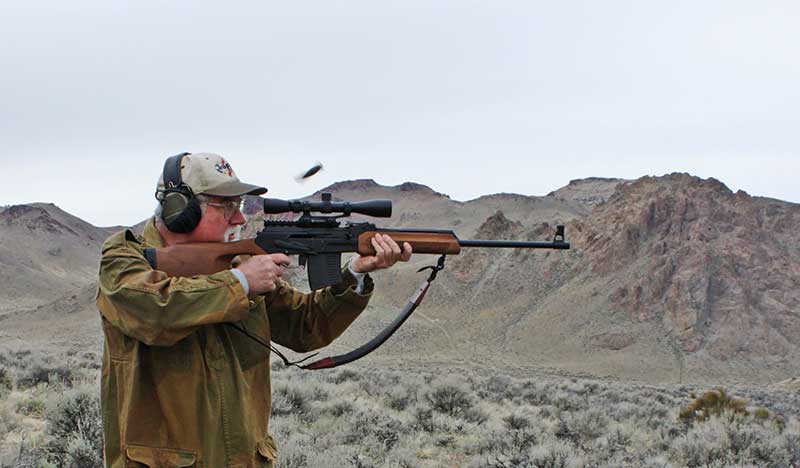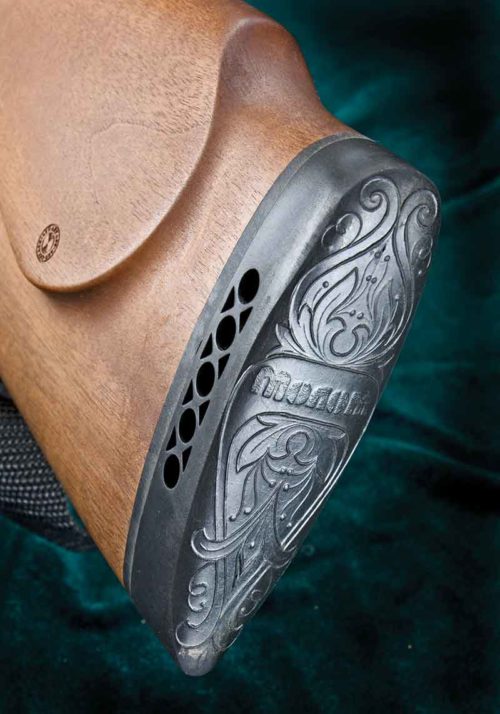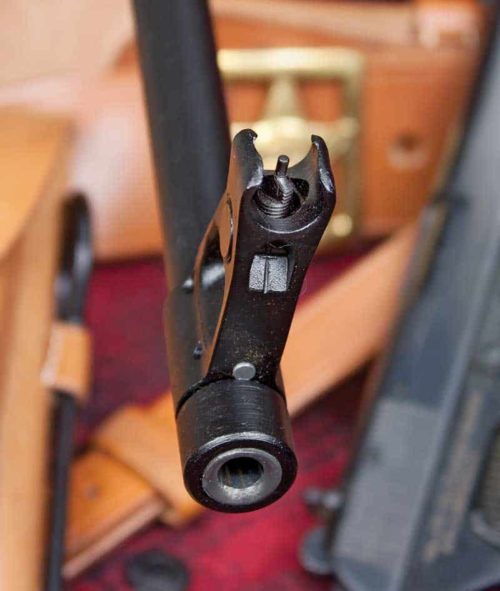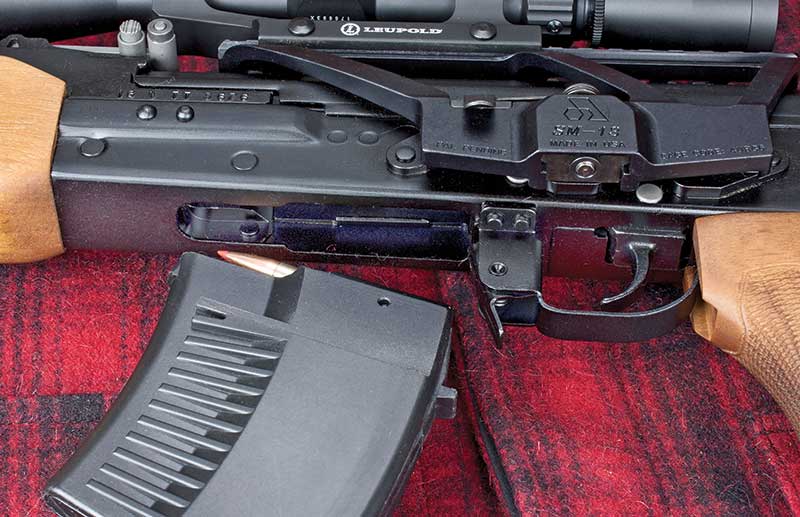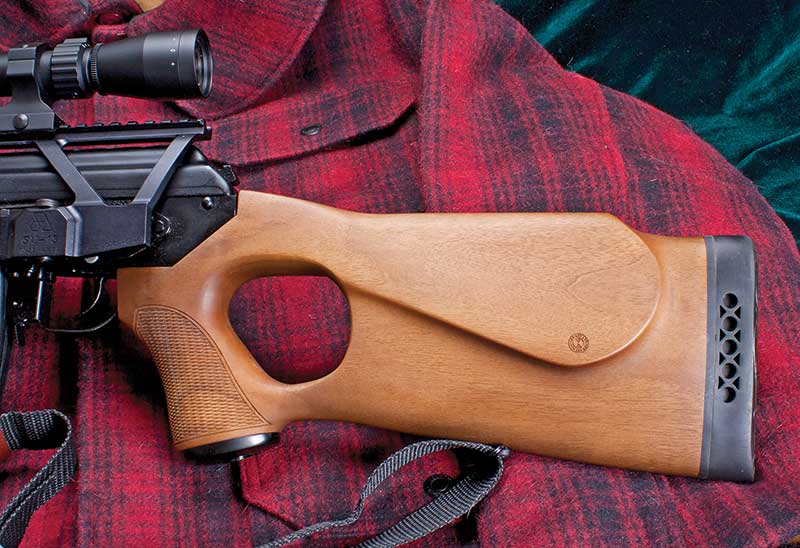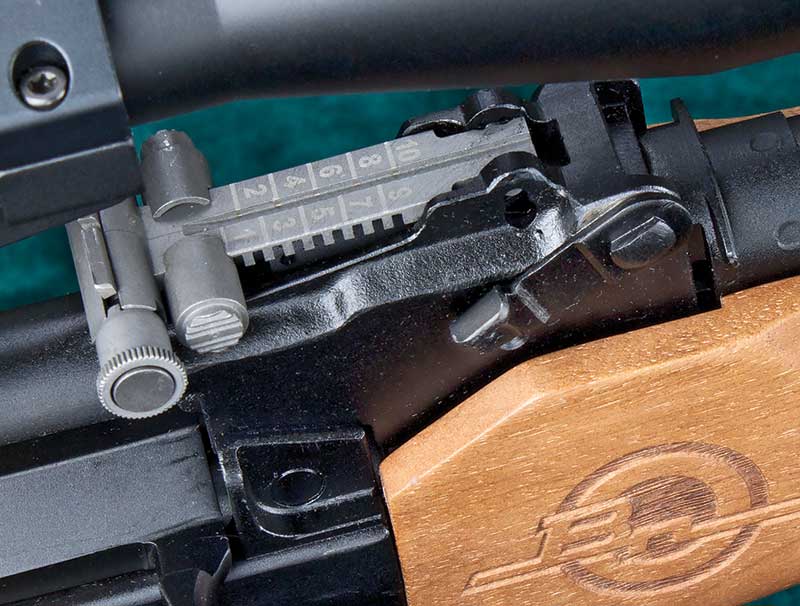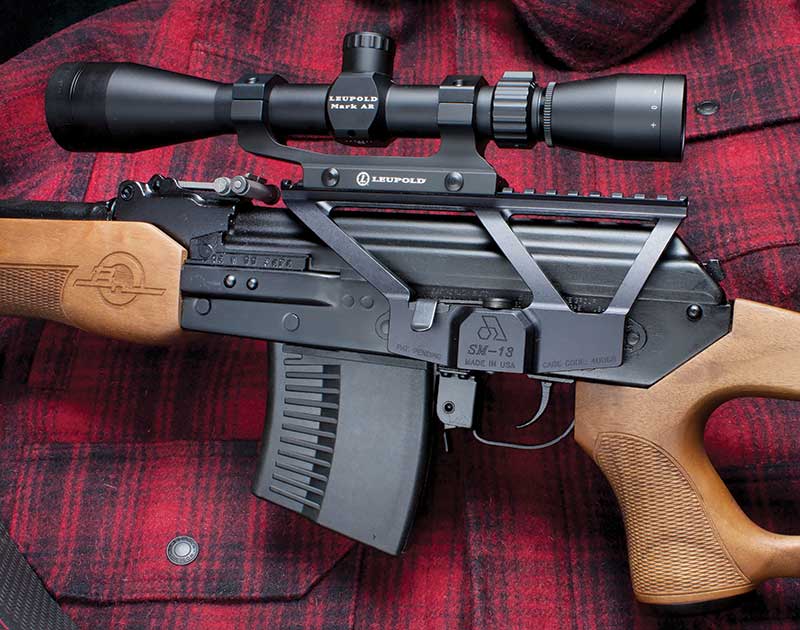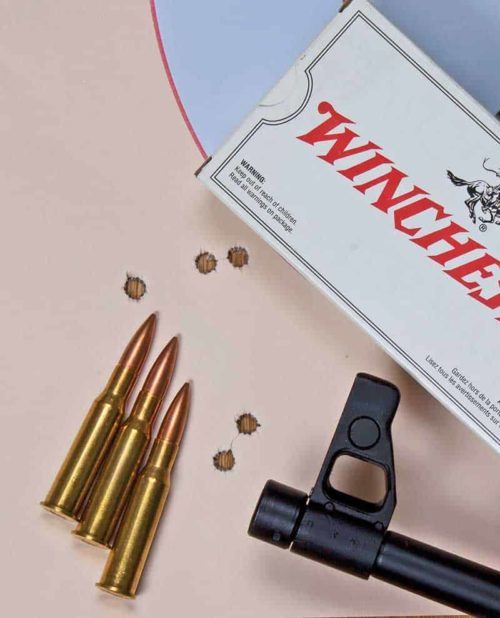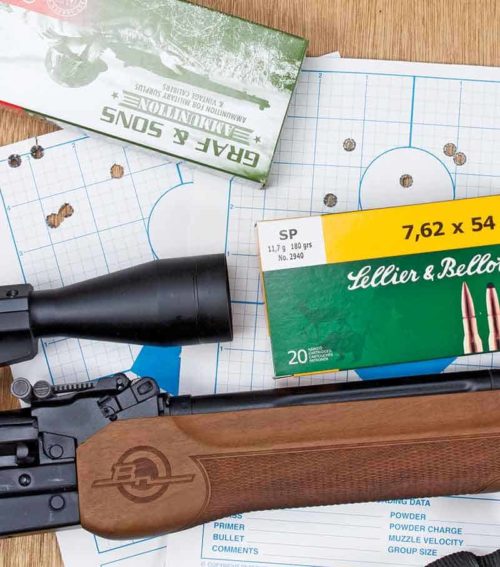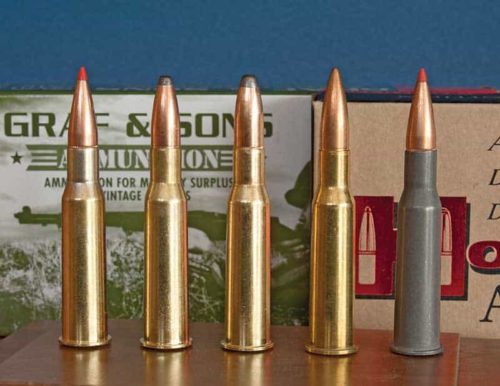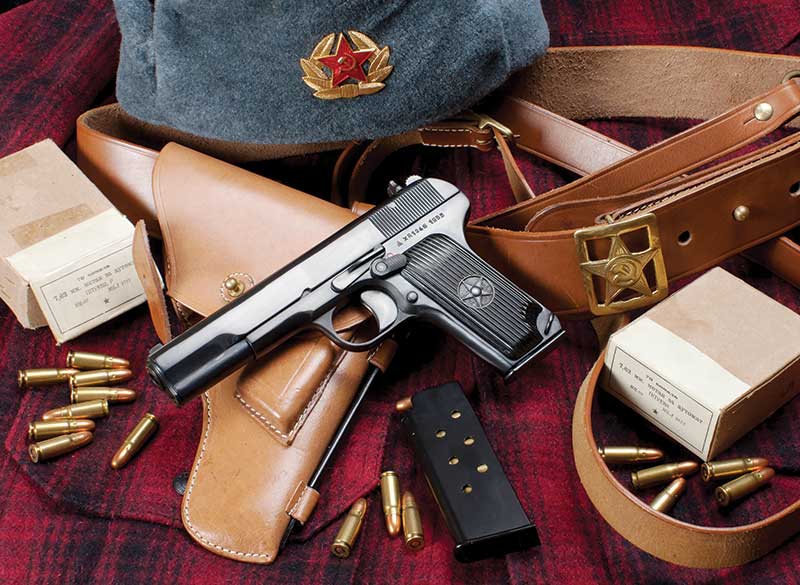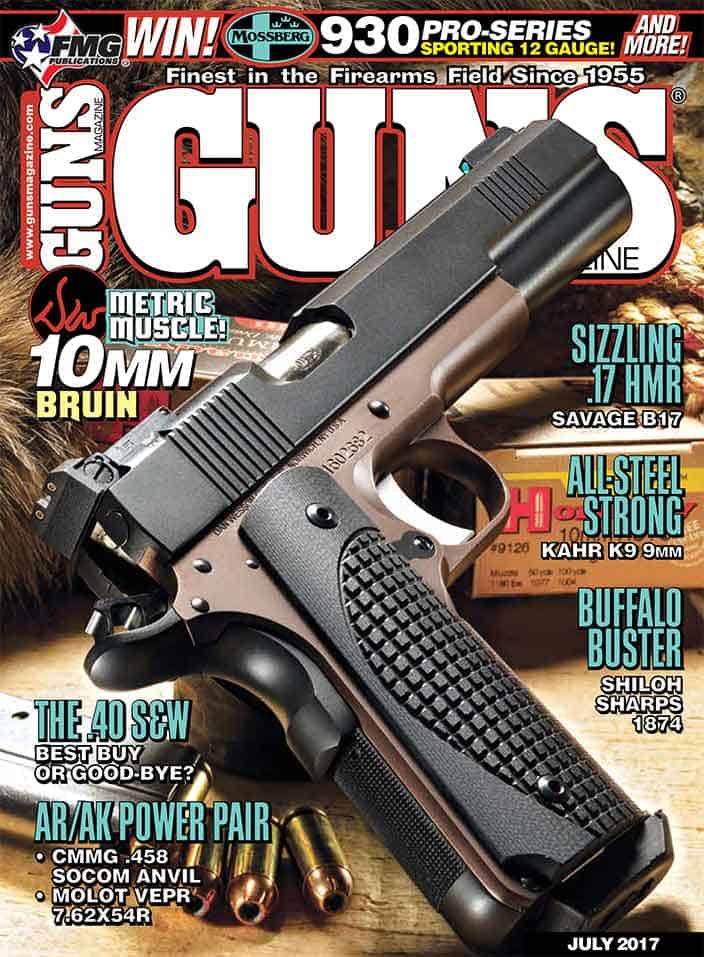Comrade Kalashnikov
Goes Hunting
The Czarist-Era 7.62x54R Cartridge In An Iron-Curtain
AK Is Just The Ticket For American Big Game
American and Western soldiers have been facing the wrong end of a Kalashnikov rifle for better than half-a-century now and if the Molot Vepr catches on, the North American cervid population may reap a similar whirlwind, as the new AK chambers calibers suitable for all big-game in the lower 48.
Molot is the Russian factory more famous for the RPK 7.62x39mm Light Machine Gun, and the company has modified this much sturdier version of the basic AK-47 into a hunting rifle chambered for more decisively lethal hunting calibers.
The Vepr operation is Kalashnikov all the way, featuring the long gas-piston operation of the AK, a similar manual of arms, but differs from the infantry AK in construction. Its parent RPK—a squad automatic weapon—was designed for the sustained high volume fire of a light machinegun. Based on the RPK, The Vepr receiver is made from thicker 1.5mm steel rather than the 1.0mm standard for a stamped-receiver AK. The barrel is heavier, too, about twice as thick as the average AK, allowing Molot to expand the platform to handle more powerful cartridges such as the .243, 6.5 Grendel, .308, .30-06 and 7.62x54R in addition to the standard 7.62×39, .223 and 5.45.
Our sample is chambered in the 7.62x54R, the longest serving military cartridge in the world, having been in continuous service since 1891. Today, it still serves in the infantry role in the Dragunov, as well as in heavy machineguns. It seemed an appropriate caliber for a Russian hunting rifle, and the .30’s in this class are certainly useful hunting cartridges. There are hunting loads available, and though most come from offshore, domestic challengers led by Hornady and distributor Graf & Sons are making inroads.
Historically, barrels in the 7.62x54R have been found with a wide variety of groove diameters, with the standard being .0311 inch. The Vepr comes with a hammer-forged, chrome-lined 4-groove, 0.311-inch barrel (discovered by slugging the barrel with a Speer lead roundball). After tapping the ball into the barrel, it pushed easily through the bore, with only the slightest amount of tightness around the gas block. Vepr states the barrel has a 1:9.4-inch twist (which is the current specification for the Dragunov SVD), so it is fast enough for the heavier hunting bullets available in this caliber.
Speaking of hunting, operation of the Vepr action isn’t as noisy as some, but the proper way to load the rifle is to pull back the reciprocating bolt handle and let it fly. You won’t do this quietly within range of game. Unlike many self-loaders though, the action can be worked slowly and reasonably quietly during the initial charging and the bolt pushed closed over a live round. The Vepr’s bolt is easy to work, and if you’re careful, you can do it more quietly than applying the safety. The big, long safety is pure Kalashnikov, and very noisy on and off. I can disengage the safety quietly only if I move it slowly and carefully. It takes practice, and I wonder if I’d be able to do so with a buck in the scope.
Like its cousins, there is no bolt hold open. A chamber flag of some sort should go into your range kit for public ranges. Likewise, when hunting or even plinking since you can’t visibly tell the rifle has an unloaded chamber. With the safety applied, you can still pull back the bolt far enough, and quietly enough for a chamber check.
The trigger is pure military, too. During the squeeze, initial travel is light and gritty, then stops. A little heavier pressure and a little more travel occur before let off. It is surprisingly manageable, once you get used to it. While both TAPCO and Jard make replacement triggers, I got the hang of it after shooting it a bit. The pull-weight of this factory trigger is between 5-1/2 and just over 6 pounds, although it feels lighter. Molot recommends the Vepr never be dry fired, by the way. Oops.
The system for mounting the scope is simple and time tested. Like its military predecessors, the Vepr comes with the siderail riveted to the left side for a quick-detachable mount. The American-made Arsenal SM-13 scope mount used here features a long Picatinny rail centering the scope over the receiver. The mount slides on the rail and its lever rotates 180 degrees to lock. Molot offers other mounts with integral 1-inch or 30mm rings.
The SM-13 mount sits low over the dustcover, and centers the scope over the boreline. The mount had a little play out of the box, but has an ingenious slack adjusting system easily manipulated by fingers alone. The instructions were clear, and one turn tightened up the scope mount rock steady. The adjusting nut has 6 slots that lock into a corresponding tooth in the base so it is captured and won’t loosen.
The base sits low over the receiver cover, and Leupold medium PRW rings were too low. With high rings unavailable, I went with the AR Riser mount. The scope is higher than I like, but everything now functions.
There are several military-style scopes and mounts for these AK variants. Beginning with the 1960’s-era Dragunov, the scope sits left of the bore-line so the soldier could access the iron sights. This means your shots cross the sighting plane as range increases (more important to a soldier than a hunter). These Soviet-era-style scopes and mounts abound. Adding to the confusion is the Soviet mounts are of different heights for AK’s and Dragunovs or SVD’s, so be aware if you go there. They look cool, are inexpensive, and the windage correction mostly unimportant for a hunting rifle unlikely shot within 200 yards.
Speaking of iron sights, the military-style ones provided are fully adjustable (not surprising, since the RPK has similar ones). The sight picture is similar to, but finer than the Patridge-style of a handgun. The rear sight appears to be Parkerized grey, and is windage and elevation adjustable. Windage is adjusted by a locking dial on the right side. Pulling out the dial and turning it adjusts the windage. Each graduation marked on the sight equals one full turn of the dial, and the dial locks at 1/2-turn intervals. The tangent-style military sight is graduated out to 1,000m. Pressing a button allows the slider to move for elevation, and locks in place at 100m intervals.
The wing-protected round-post front sight is pure AK, and can be turned in or out to fine-tune the elevation. Along with the rifle comes a buttstock cleaning kit in a metal tube. While the stock has no port to accept the kit, inside are some useful tools, including a screwdriver/front sight key. The container for these parts has a slot in its middle you slip over the front sight adjusting key creating a T-handle for leverage. Nifty.
Oddly, when shooting with the irons, the wings of the front sight peak above the rear sight plain like a little devil’s horns. Surprisingly, they are an aid in maintaining a correct sight picture.
The stock is walnut, and the normally square AK receiver has been given an angle cut to accommodate the sporting-style thumbhole stock. It is well executed and comfortable to mount. I was surprised the length-of-pull measured 14 inches. It snaps to my shoulder more easily than a 14-inch LOP normally would.
In carrying, the balance point is right around the chamber area of the rifle where the magazine and bolt handle are. The magazine pushes your hand far enough forward the bolt doesn’t stick into your palm. It is not uncomfortable to carry with one hand, although in my left hand, the bolt snagged my trouser pocket once in a while.
The magazine is entirely made from synthetic material. A 5-shot single stack, it is more difficult to load than a double stack. Pressing down on the top round with my thumb helps start the next into the mag.
One item difficult to rectify is the narrow European sporting sling swivels. Few slings in America fit the narrow 7/8-inch swivels. In addition to being narrower than the 1-inch American standard, the swivel mounting screw sits high within the loop. This precluded use of slings with nylon QD attachments (which would have needed a trim to fit anyway). I found I could thread the simple 1-inch nylon strap of the inexpensive Hunter MagnaSoft sling through the swivels. If you buy a Vepr for hunting, spend a little more time in the gun shop looking for a suitable sling. The use of an Uncle Mike’s stud would’ve been preferable, since it gives you a choice of swivel widths.
I find the gun slings easily from the right or left side. Slung on the left side, the bolt is high enough on the receiver it doesn’t dig into my side as I walk. The Hunter padded sling is quite “springy” and comfortable.
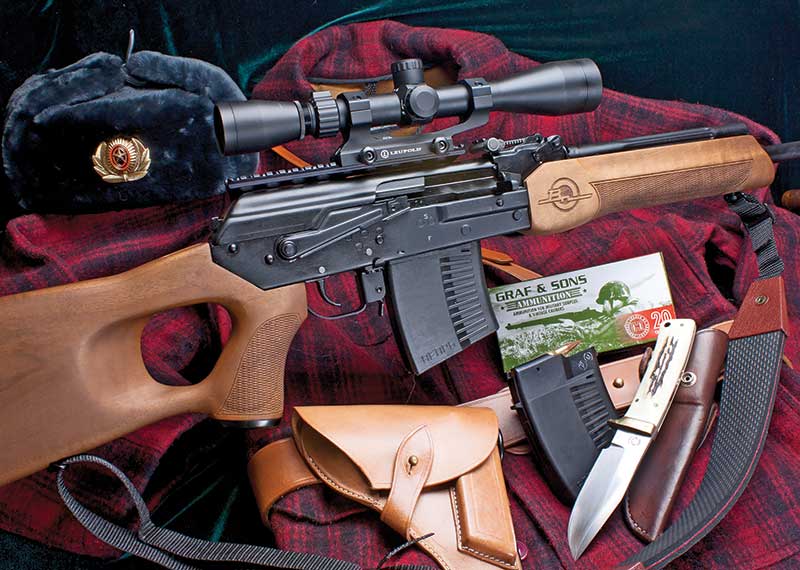
East meets West in pursuit of game. The Molot Vepr in 7.62x54R is a capable hunting rifle especially topped
with a Leupold 3-9X in Arsenal mounts shooting today’s ammunition, like Graf & Sons loaded by
Hornady with the firm’s 150-grain SST. Keeping warm is a snap wearing a Russian Federation officer’s
ushanka atop a Woolrich “Pennsylvania Tuxedo.” Why not go all the way? A 7.62x25 Tokarev makes a
dandy small-game and dispatching pistol in a reproduction WWII rig from World War Supply. A Tom Farrell
custom knife adds a touch of class to round out the East/West accouterments.
Ammo & Shooting
I chose to stick with quality hunting ammunition, since the Vepr is a hunting rifle. None of the choices were big bucks, and hunting loads from Prvi Partisan, Sellier & Beloit and ammo loaded for Graf & Sons by Hornady and Hornady Steel were chosen. Most of what I see in the stores were Wolf and Tula steel-cased. Looking for a wider selection, Graf’s was the natural place, since they stock most of the majors. And all were in stock.
It was in the high 30’s at the range and a quirky thing started the day while fussing with the sights at the 25-yard line. Loading 2 rounds caused the bolt to close over the rounds without picking one up. The magazines were difficult to insert into the gun. In exasperation, I loaded 5 rounds and the behavior instantly changed. The magazines now seated smoothly, and the rounds fed and extracted perfectly. No other malfunction ever occurred during the rest of the test. Maybe my fingers and dexterity were affected by cold.
On Day 1, the trigger took some time to get used to. Eventually I found a technique of tugging through the gritty 1st stage, pausing at the 2nd, then squeezing smoothly through to achieve some pretty decent groups. I could see the bullet hits on the bright white of the Mountain Plains targets through the scope and able to see the 5-shot groups enlarge after three were in. Two of the best 5-shot groups were with Prvi Partisan and Winchester USA. The PP load was three shots into 1-1/2, four into 2-1/2 and the fifth took it all out to 4-1/4. With the scope removed, the last group of the day was shot with Winchester USA and was a 5-shot 100-yard group of 2-1/2 inches, with the best three in 1-3/8 inch.
Day 1’s best 3-shot group came from the Sellier & Bellot 180-grain load at 1-5/16, and it was the most comfortable round to shoot. It also shot much higher than the 150’s, and the rifle would need to be rezeroed for both windage and elevation. All the 150-grain loads recoiled a little snappier, but none uncomfortably.
Ejection with all loads was brisk and fairly unpredictable, landing in a wide arc about 30 feet starboard and aft. Many of the cases received bad neck dents and most have body dents, but nothing to preclude reloading. The rangemaster erected a brass net after seeing their wicked trajectory, and the worst neck damage occurred when the cases hit the concrete. Netted, the cases had some body dents, but little neck damage.
On Day 2 I started with a freshly cleaned barrel and shot the iron sights first. My very first 5-shot, 100-yard group after firing one fouling shot into the berm was 1-3/8 inches with the Graf’s load. This time I goofed off with another gun between groups while this barrel cooled thoroughly. While I never bested that group, I got several 3-shot groups as good, with shots 4 and 5 taking the group out to the 2-1/2- or 3-inch range.
Putting on the scope, I never got as good a 5-shot group as my first iron-sight group of the day, but several 3-shot ones were as good from Graf’s, S&B and Prvi.
Even dirty, it certainly shoots well enough to make the resident deer population nervous, and the round delivers plenty of power in a comfortable shooting—if heavy—rifle.
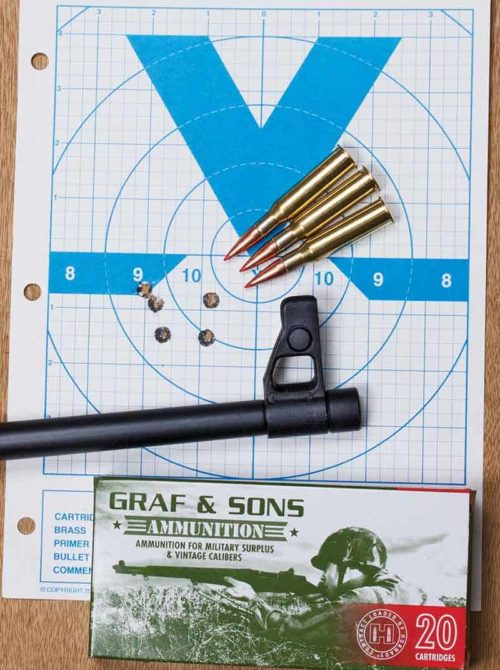
From a freshly cleaned barrel, the Vepr delivered this outstanding iron-sight, 5-shot
group of 1-3/8 inches at 100 yards with Graf’s (above). With the barrel dirty and the
scope mounted (below) , 3-shot groups were within 1-3/8 inches, but 5-shot groups grew
into the 2-1/8- (Graf’s) to 2-7/8-inch (S&B) range.
Comrade Handgun
I always prefer rifle/handgun combinations, and the obvious choice for the Vepr is the Tokarev or Makarov. Funny thing is, the more I thought about the T-33, the more it—or at least the cartridge—began to make sense. The 7.62x25mm is a heckuva flat-shooting round. The little 86-grain bullet travels some 1,450 fps and I find it most fun to shoot at long range. It is no problem to hit (or at least frighten terribly) clay pigeons at 50 yards and more. I was reminded of the time I was quail hunting with a shotgun and was dogged by a wily coyote just out of shotgun reach. Since then, I’ve always taken along a 40-ounce 1911 in either 10mm or .38 Super.
The all-steel Tokarev weighs only 30 ounces and comes with a fairly good set of fixed Patridge-style sights. For small game, pests and critters up to coyotes, I wouldn’t feel undergunned with the Tok, and it would take small game like bunnies for camp meat without tearing them up, and work just fine as a dispatching pistol.
My Romanian version has been modified for the USA with the inclusion of a thumb safety, but lacks an inertial firing pin. Originally, the Tokarev had no safety except for a 1/2-cock notch, and was dangerous to carry unless the chamber was unloaded. There are several different ways exporting companies modified these pistol for importation, but wiser folks carry them with the chamber unloaded.
While I’d eschew going afield rigged up in a Soviet Sam Brown rig, I found the full-flap holster quite useful. When shooting in the desert for these tests, I often sling the rifle when setting up targets. It gives a feel for how the rifle will behave afield. I added the reproduction right-side holster from World War Supply and discovered it keeps the rifle from clacking against the butt. It isn’t a quick draw, but if I needed to shoot something fast, I’d use the rifle first.
I believe the 7.62×25 is an underrated hunting round and worth exploring further. Both Hornady and Sierra offer suitable expanding bullets, and Starline offers brass. Outside of expensive war trophy Tokarevs, the imported ones are still reasonably priced and fit right in with a Vepr.
Mark AR
Maker: Leupold & Stevens
14400 Northwest Greenbriar Parkway
Beaverton, OR 97006
(503) 646-9171
www.leupold.com
Magnification: 3X-9X,
Objective Diameter: 40mm,
Eye Relief: 4.7 inches (3X), 3.7 inches (9X), Internal Adj.
Range: 56 MOA elevation & windage at 100 yards,
Click Value: 1/2 MOA,
Tube Diameter: 1 inch,
Weight: 12.5 ounces,
Overall Length: 12.4 inches,
Reticles: Mil-Dot (tested), plex,
Price: $374.99
Vepr
Maker: MOLOT, Kirov Oblast, Russian Federation
Importer: FIME Group
4395 W. Post Rd, Unit 200
Las Vegas, NV 89118
(702) 215-3600
www.FIMEGroup.com
Action type: Gas operated rotating bolt
Caliber: 7.62x54R (tested), .223 Rem, 5.45×39, .243 Win, 6.5 Grendel, 7.62×39, .308 Win, .30-06
Capacity: 5
Barrel length: 23.2 inches
Overall length: 42-3/4 inches
Weight: 10 pounds, 10 ounces (with scope)
Finish: Blue, Sights: Patridge front, adjustable rear
Stock: Walnut, checkered, satin finish
Price: $879.99
Arsenal Inc.
4395 W. Post Rd. Unit 100
Las Vegas, NV 89118
(702) 643-2220
www.arsenalinc.com
Graf & Sons
4050 S. Clark
Mexico, MO 65265
(573) 581-2266
www.grafs.com
Hornady
P.O. Box 1848
Grand Island, NE 68802
(308) 382-1390
www.hornady.com
Hunter Co.
3300 West 71st Avenue
Westminster, CO 80030
(303) 427-4626
www.huntercompany.com
Mountain Plains Targets
3720 Otter Place
Lynchburg, VA 24503
(800) 687-3000
www.precisionplustargets.com
Sellier & Bellot
248 Apollo Drive, Suite 180
Lino Lakes, MN 55014
(800) 466-7191
https://www.sellierbellot.us
Winchester Ammunition
600 Powder Mill Road
East Alton, IL 62024
winchester.com
World War Supply
P.O. Box 72, Ada, MI 49301
(616) 682-6039
www.worldwarsupply.com

